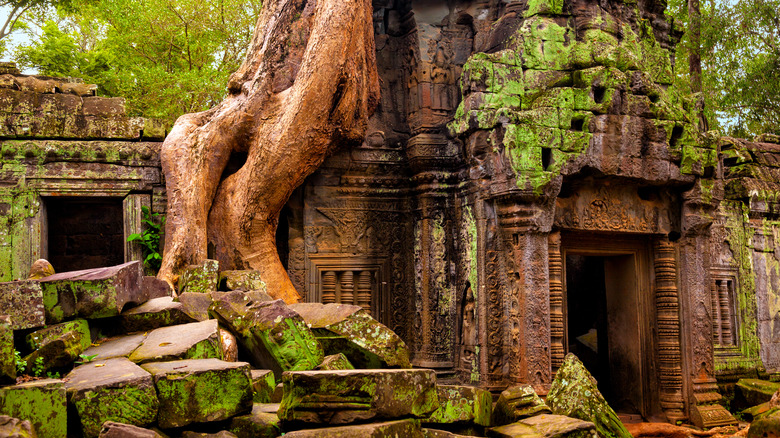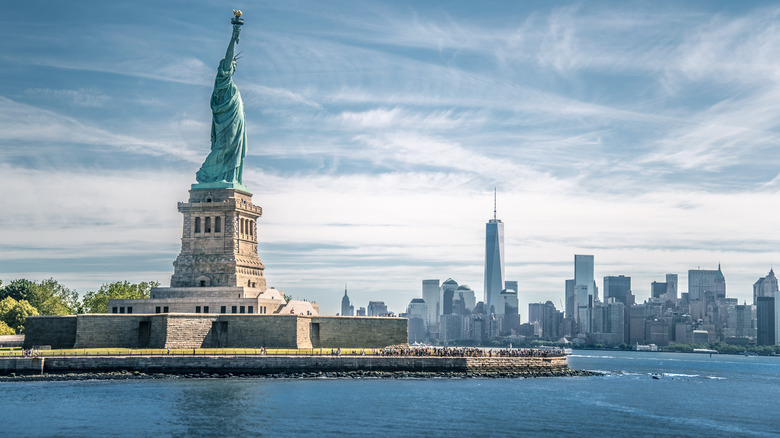
How Angkor Wat Was Really Built
Towering faces that point in all four cardinal directions, intricate bas-relief stonework depicting heroic exploits and quotidian scenes of everyday life of the ancient Khmer people, and dozens of spires pointing up out of 500 acres of jungle canopy. These are the attractions that draw millions of tourists each year to the ancient Khmer temple called Angkor Wat, in modern-day Cambodia. According to Anchor, the temple complex known today as Angkor Wat was actually two cities built during the successive reigns of Khmer Kings Suryavarman I and Jayavarman VII, and the gigantic faces on the towers at the Bayon Temple were stylized after the latter, depicting him in the semi-divine Buddhist state of enlightenment known as “bodhisattva.”
Angkor Wat was abandoned in the 15th century, when the Siamese people of modern-day Thailand invaded the region and ransacked the city and temple complexes. While what remains today is still breathtaking, the complex and accompanying city was much bigger than what tourist gape at these days. There now remain around 200 faces in the Bayon Temple, but it is believed that there were once as many as 200 towers, each bearing four royal faces. It may seem incredible that such a sprawling city was built so quickly — in less than four decades — but the ancient Khmer had an ingenious method of construction that enabled them to build such world-famous structures in such a short amount of time.
The canals at Angkor Wat helped the Khmer move materials efficiently
Indeed, what remains of Angkor Wat is just a palimpsest of its original grandeur. According to the BBC, the main temple complex was merely the nucleus of a huge city comparable in size to modern-day Berlin. The city’s various neighborhoods were connected via a complex system of roads, canals, dams, and reservoirs, and this use of the water allowed the Khmer to build the temples so efficiently. They transported the large sandstone boulders used in the construction via the canals, greatly reducing the time and effort involved in moving them.
But this knack for efficiency would ultimately be Angkor Wat’s downfall. For while the Siamese military incursion was the catalyst for the city’s abandonment, the city was already in decline at the time. The ambitious growth of Angkor Wat had dire consequences on the environment, such as unsustainable deforestation, degraded topsoil, and an irrigation system so complex and overworked that it required a ridiculously large workforce just to keep it maintained and running properly. For its part, however, the jungle has done a great job of taking back spaces the Khmer claimed centuries ago. At temples like Ta Prohm, the cotton silk trees rend cracks in the stone walls with their crawling, tentacular roots.

Jackie Kennedy Nearly Married This Man Instead Of JFK

What You Should Know About The Holocaust Avengers

The Interesting Truth About The Black Sea Deluge

Rules The British Royal Family Have To Follow Forever

Were The Mongol Conquests And Invasions The Most Brutal In History?

The Odd Reason Charles Manson's Mother Was Sent To Jail

The Sad Story Of Fertile Hagar In The Bible

The Bizarre Story Of The MLB Player Who Hit A Fan With Two Foul Balls

What Really Happened To Children Of God Founder David Berg?

The Truth About Rodney Alcala's Time In The Military
























